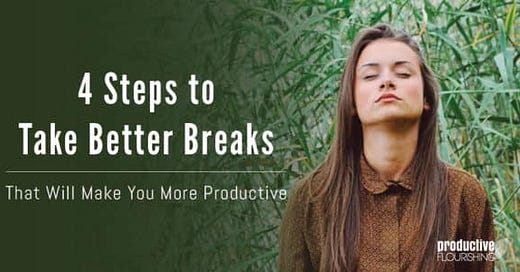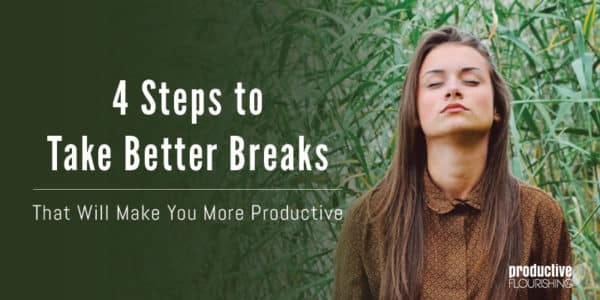4 Steps to Take Better Breaks That Will Make You More Productive
What if being our best selves actually means stepping away for a while?
Editor's note: This is a guest post by Jeffrey Davis.
Many of us get caught in a productivity paradox. On one hand, we wish for that proverbial extra hour in a day that allegedly would let us accomplish everything on our to-do list. On the other hand, if we do actually take time off for ourselves — especially during a work day — we don’t really know how to break well.
❤️ Hello, checking Instagram hearts.❤️
What if we could free ourselves from that paradox by not only working well but also breaking better? What if we developed not only a strong work ethos but also a strong wonder ethos — a wonder ethos that oddly enough would help us work well?
We can. If you consistently test out certain intervention activities during your workflow, you might notice a subtle, yet vital shift: You might increase rather than sidetrack your productivity. To top it off, you also might make space in your day for delight and appreciation. (You know, those things that give life and work meaning.)
Here are four steps to help you break better:
1. Notice When You’re Closing Down…
To stave off feeling overwhelmed, recognize when you’re reaching your limit. This step is crucial during your work day. Think of your car’s near-empty gas signal lighting up. It’s an indicator that you’re almost out of fuel. You don’t ignore it. You stop and fuel up. Similarly, we can be more aware of our own “workflow dashboard indicators,” so to speak. These indicators signal to us that we’re closing down and that it’s time to respond proactively with a better break.
Cognitively Notice if you’re struggling to think through problems or finding issues insurmountable. Suddenly your to-do list feels more like a ball and chain. Rather than being able to logically parse out what to do next, you’re locked in inaction.
Relationally Isolating yourself is often a strong indicator of when you’re closing down. Rather than talking through your problems or creative blocks, you keep it all on your plate, afraid to let anybody else see how the work is building up.
Creatively Destructive perfectionism and frustration may creep into your decision-making process. Rather than feeling engaged and stretched by a project, you find it hard to know when a project is complete or when you should just start over.
Energetically Observe when you’re getting exhausted and grumpy. In need of a boost, you scarf some high-sugar snacks, down another cup of Bulletproof Coffee, and diddle on Facebook for a few dopamine hits — all with the hope that you can fight your way through your work.
2. … and then Break Better
Rather than surrendering to the feelings of closing down, acknowledge them as being present. Then train yourself to break better.
From my tests and assimilation of current research in psychology and creativity, I recommend that such a break last from 40 seconds to 20 minutes during traditionally “full” work days. To do so, start by directing your attention away from a screen. If you need to, turn off the device entirely. While the digital world brings us lots of temporary joy, too much time on the screen is an energy and mood suck.
When we break better, though, our attention instead is turned toward the sensory world, another person, or your own thoughts and ideas. This direction of attention almost acts like a “mini-meditation” of mindfulness that calms your brain’s distracting impulses. Such a mindful break can increase your chances of being more creative rather than reactive for the rest of the day. PRODUCTIVE FLOURISHING Here are two interventions you can test out.
45-Second Wonder Intervention: Pause, Gaze, Praise
Pause: Give yourself 45 seconds away from your work at hand.
Gaze: If you have the opportunity to go outside, this is ideal. Otherwise, take a look out the window or look at an image of a natural scene. But gaze. That is, keep your eyes soft and steady on one visual plane for 45 seconds. Doing so triggers your brain’s direct experience network, the network associated with presence and mindfulness.
Praise: Allow your thoughts to wander and play a little, or just follow your own curiosity. But don’t let your thoughts float away. Instead, use this wandering time to muster in your mind a few words of appreciation for whatever you happen to be gazing upon. My clients have praised everything from coffee cups full of Uni-flo pens to bare-branched trees, and from a blade of grass to a worn-out bench.
Using this process, even for 45 seconds, shifts your attention away from your work at hand and opens your perspective for a few moments.
A study in 2015 concluded that participants who viewed a green roof for a 40-second micro-break were better able to sustain their attention on the task-at-hand after the break.
By changing your physical surroundings, you also allow your mind the freedom to play for a moment before coming back to the task in hand.
20-Minute “Other” Lunch Break
While regularly breaking better will feel antithetical to getting work done, setting aside time to not work is vital. If you’re isolating yourself in your work, take the opportunity to talk to colleagues, team members, or anyone else you encounter on your break. But here’s the vital guideline: Practice asking questions, listening, and learning about another person’s point of view.
Funny enough, it might be in such listening that a new idea ferments. The work of many social psychologists as well as the seminal work of developmental psychologist Howard Gardner on close relationships keeps reminding us of this point: Most great ideas are not born out of isolation. Several great ideas are born out of opening up to the people right around us.
Once you end your “other” lunch break, you can go back to your work feeling refreshed and enlivened.
3. Schedule Better Breaking
If you tend, like I do, to “work hard” in long stretches, set a timer to go off after 90 minutes or two hours to signal you to take a deliberate break. I prefer the Enso timer and Enso timer app because of its options for meditation bowl sounds and alarm alerts.
This proactive approach to your needs can help you focus more efficiently. Some research has found that when we work within measurable time frames, we can focus better. Using a short time frame increases the amount of “good stress,” yet keeps the effort specific to the task at hand.
If you know, for example, that after an hour your mind starts to wander, schedule an opportunity to break better every 55 minutes. Set an alarm and stick to it. Then, step away from your work space and do something quiet. Draw or record your observations and thoughts in a notebook, go for a walk, or have a good listening talk with a coworker or friend.
4. Test, Learn, Iterate
Treat breaking better like an experiment. Start with a flexible hypothesis such as, “If I break better for 15 days, I will notice a boost in my creativity and in my capacity to focus throughout a work day.”
Then show up and test out your theory. If you keep a planner, include the breaks in your day’s planner either ahead of time or in hindsight. At the end of the work day, schedule time to evaluate your day. Go through your to-do list and reflect on how focused and creative you have or haven’t been. Write down what kinds of breaks you want to continue testing and what steps you can take to help you remember to do so. Finish your evaluation by writing down what you need to do tomorrow, so you can free up your mind for “break better” hours.
If you ever get trapped in feeling irresponsible for breaking better, consider this: What if being our best selves actually means stepping away for a while and taking better and longer breaks? If that’s true, then we should practice “breaking better” because it lets us better serve our people and our projects.




